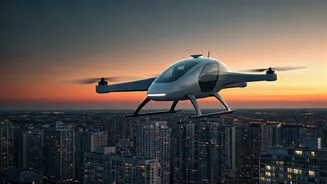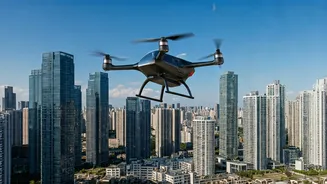Visionary Andhra Pradesh
The state of Andhra Pradesh is charting a course towards the future of urban mobility by setting its sights on the ambitious goal of deploying drone taxis
by the year 2027. This initiative showcases a forward-thinking approach to addressing the challenges of conventional transportation systems, such as traffic congestion and limited accessibility. The core vision revolves around leveraging the capabilities of unmanned aerial vehicles (UAVs), commonly known as drones, to provide a swift, efficient, and potentially eco-friendly means of transport within the state. This leap forward necessitates comprehensive planning and strategic execution, as it integrates cutting-edge technology with the existing infrastructure. The implementation of drone taxis necessitates not only the acquisition of suitable vehicles but also the establishment of necessary regulatory frameworks, safety protocols, and operational infrastructure. Andhra Pradesh's proactive stance exemplifies its commitment to innovation and its eagerness to become a pioneer in the adoption of advanced transportation solutions, thereby paving the path for a new phase in urban development and transport.
Drone Taxi Advantages
Drone taxis present several advantages that make them a compelling solution to modern transportation woes. Foremost, they offer the potential to significantly reduce travel times, as they bypass ground-level traffic congestion by operating in the airspace. This efficiency can lead to considerable time savings for commuters, especially in densely populated urban areas where road traffic is frequently slow-moving. Furthermore, drone taxis are anticipated to enhance accessibility, as they can provide transport to areas that are not easily reachable by existing public transport networks. This is especially beneficial for people residing in remote or poorly-connected locales. In addition, the use of electric drones can contribute to environmental sustainability by reducing carbon emissions and lessening reliance on fossil fuels. These vehicles promise a quieter and cleaner mode of transportation, which can improve air quality and decrease noise pollution. The integration of drone taxis can also support the development of smart city initiatives, thus integrating advanced technology and data analytics to optimize urban functionalities and enrich the quality of life for citizens.
Challenges and Hurdles
The path to realizing the vision of drone taxis in Andhra Pradesh is not without its difficulties, and overcoming these challenges is critical to ensure a successful deployment. One of the main hurdles is establishing a solid regulatory framework that ensures the safety of air travel and the efficient management of airspace. This involves defining operational guidelines, certification standards for both vehicles and operators, and addressing issues related to air traffic control and navigation. Another essential consideration is the technological aspect. The drone technology must meet stringent safety requirements, including robust fail-safe mechanisms, reliable communication systems, and advanced autonomous navigation capabilities. Furthermore, the development of adequate infrastructure, such as drone ports or vertiports, is crucial for seamless operations. These facilities will act as takeoff and landing sites and will require appropriate land use planning and integration into existing urban infrastructure. The public acceptance and adoption of drone taxis is another factor. Concerns about safety, privacy, and noise pollution could impact the general willingness to use these services. Addressing these concerns through effective communication, demonstration projects, and public engagement will be necessary to foster widespread adoption and acceptance.
Future Readiness in AP
Andhra Pradesh's readiness to embrace drone taxis by 2027 suggests a series of strategic initiatives that must be implemented. First and foremost is the partnership with technology companies and aviation experts to leverage their expertise and resources. This collaboration is crucial for the procurement of appropriate technology, the development of operational protocols, and the continuous improvement of the system. Investing in infrastructure is another crucial aspect. Building a network of vertiports, charging stations, and maintenance facilities throughout the state would be essential to facilitate the smooth operation of drone taxis. A major focus is also given to the training and certification of pilots and maintenance staff, which ensures the availability of skilled personnel to run these systems. Additionally, continuous monitoring and evaluation of the program are necessary to refine the system based on actual performance data and user feedback. This data will help refine operations, improve efficiency, and respond to arising challenges. The implementation of drone taxis is also likely to generate economic opportunities, particularly in terms of high-skill job creation and driving innovation within the state. By proactively addressing these needs, Andhra Pradesh is not only getting ready for the future of transportation but also setting a model for other regions in India to follow.














